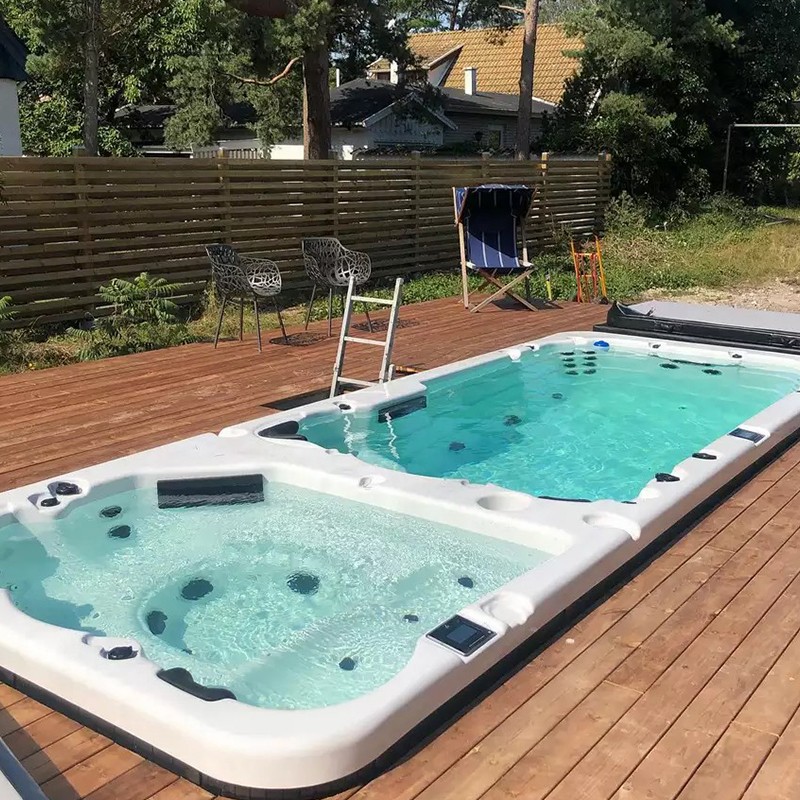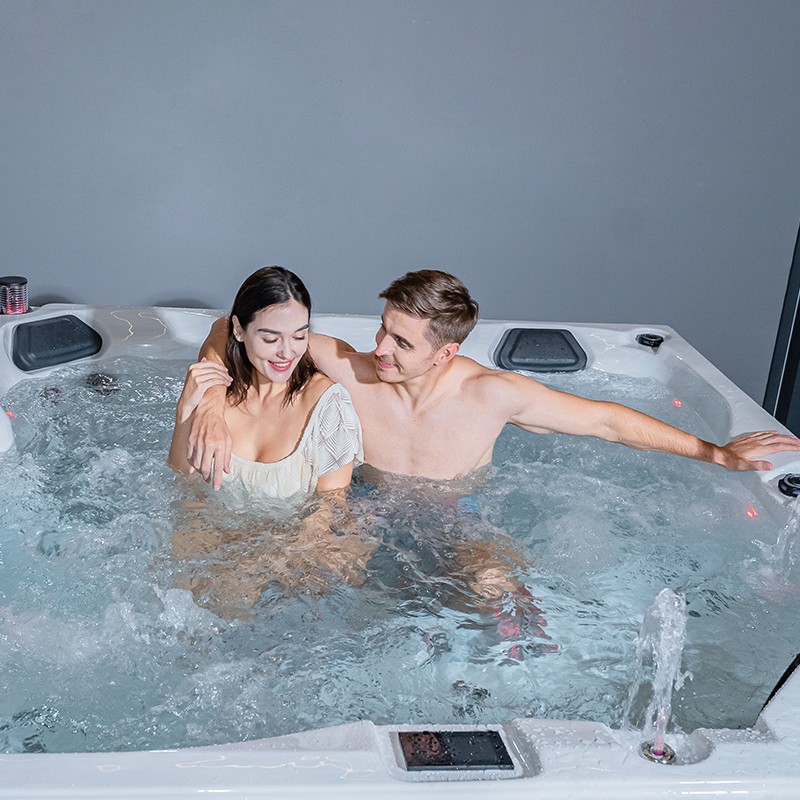
Does cloudy water in a spa jacuzzi bathtub mean high calcium content?
2025-11-28 15:30Many people encounter a confusing phenomenon when using a spa jacuzzi bathtub: freshly changed water appears crystal clear, but after heating, circulation, or several uses, the water becomes cloudy, whitish, or even milky.
This leads some users to wonder—does cloudy water in a spa jacuzzi bathtub mean the calcium content is too high? In fact, while calcium ions in water can indeed be one cause of cloudiness, it doesn't mean that every instance of cloudiness is related to calcium.
Cloudiness in spa jacuzzi bathtub water is often the result of a combination of factors, including water hardness, chemical imbalance, organic contamination, and filtration system problems. This article will provide a professional analysis to help you restore clear, pristine water quality.
Why does spa jacuzzi bathtub water become cloudy?
The water in a spa jacuzzi bathtub is not simply a static container like a bathtub; it's a dynamic, circulating system. During use, the water is heated, pressurized, and circulated, creating bubbles and impacting the water flow through the nozzle.
Therefore, any slight chemical imbalance, contamination, or sediment can cause turbidity.
Common causes include:
• High calcium and magnesium ion content in the water (hard water problem)
• pH or alkalinity imbalance
• Residual organic matter, body oils, and skincare product ingredients in the water
• Clogged or malfunctioning filtration system
• Infrequent water replacement during circulation, leading to bacterial growth and turbidity
• Excessive or improper use of chemicals (such as disinfectants or clarifying agents)
Therefore, "turbid water" is merely a phenomenon and cannot be definitively attributed to "excessive calcium content" based solely on appearance.
Does turbidity in spa jacuzzi bathtub water truly indicate high calcium content?
The answer is: not necessarily.
While calcium ions can indeed combine with carbonate and bicarbonate ions under certain conditions to form calcium carbonate precipitate, making the water appear whitish or cloudy, the degree of turbidity in spa jacuzzi bathtub water does not accurately reflect calcium content.
Here's a professional explanation:
When water is heated to a certain temperature (e.g., 35°C–40°C), the solubility of calcium salts decreases, making them more likely to precipitate and form suspended particles. These particles refract light, making the water appear white or milky.
However, in some cases, even with normal calcium levels, a high pH can induce the same precipitation reaction.
In other words, cloudy water doesn't necessarily mean a high calcium content, but rather a signal that the calcium balance has been disrupted.

Besides calcium, what other factors can cause cloudy water in a spa jacuzzi bathtub?
To correctly determine the cause, we need to distinguish between different types of "cloudiness":
1. White or milky cloudiness
Common causes:
• High water hardness (high calcium and magnesium ion content);
• High pH (>7.8);
• Air bubbles mixed into the water (temporary cloudiness, disappearing after a few minutes).
2. Gray or Dark Turbidity
Common Causes:
• Clogged or malfunctioning filter cartridge;
• Suspended organic matter, skin flakes, or skincare product residue in the water;
• Excessive disinfectant concentration or incomplete reaction.
3. Green or Yellow Turbidity
Common Causes:
• Algae growth;
• Oxidation of metal ions (e.g., iron, copper);
• Aging water that has not been replaced.
Therefore, when turbidity is found in spa jacuzzi bathtub water, factors such as color, time, rate of change, and odor should be analyzed comprehensively. It cannot be determined solely by visual inspection that it is a calcium content issue.

How to determine if the calcium content in a spa jacuzzi bathtub is truly too high?
The most scientific way to determine if calcium content is the culprit is to test the water hardness.
You can determine this by using the following methods:
1. Use water hardness test strips or reagent kits
These tools can detect the concentration of calcium and magnesium ions in the spa jacuzzi bathtub water, expressed in ppm (parts per million).
Ideal range: 150–250 ppm.
Above 300 ppm indicates the water is too "hard," which may cause scaling or turbidity.
2. Observe changes when heating
If the cold water is clear but turns white or cloudy after heating, it may be due to calcium salt precipitation.
3. Inspect the bathtub interior
If you find white powdery deposits or crystalline spots on the surface of the spa jacuzzi bathtub, it indicates a calcium scaling problem.
Testing can determine whether it is caused by calcium, rather than blindly adding chemicals or frequently changing the water.
What are the dangers of high calcium content in spa jacuzzi bathtubs?
High calcium ion concentrations can cause a series of water quality and equipment problems:
1. Scale Formation
Calcium salts deposit on the heating element, nozzles, and circulation pump of the spa jacuzzi bathtub, reducing heating efficiency.
2. Turbid Water, Loss of Radiance
Suspended particles reflect light, making the water appear cloudy.
3. Nozzle Clogging and Uneven Water Flow
Scale adheres to the area around the nozzles, affecting the massage effect.
4. Shortened Equipment Lifespan
Long-term scale buildup increases pump load, causing mechanical wear.
5. Chemical Imbalance
Calcium reacts with other chemicals, affecting pH and alkalinity stability.
Therefore, even if calcium is not the only cause of turbidity, it remains an important indicator that needs to be controlled.
If it's not calcium, what causes the water in the spa jacuzzi bathtub to become cloudy?
In many cases, the real culprit behind cloudy water isn't calcium, but rather the following factors:
1. pH Imbalance
When the pH is high (>7.8), carbonate precipitation intensifies, easily leading to cloudiness.
Solution: Use a pH minus to adjust to 7.2–7.6.
2. Organic Matter Accumulation
Body oils, skincare products, and sunscreen residue in the water react with disinfectants to form tiny particles.
Solution: Use an enzyme cleaner or increase filtration circulation.
3. Filtration System Failure
Clogged or overused filter cartridges can leave particles suspended and unable to be removed.
Solution: Clean or replace filter cartridges regularly, performing maintenance every 2–4 weeks.
4. Improper Use of Chemicals in the Water
Overuse of clarifying agents or disinfectants can cause chemical imbalance, making the water even cloudyer.
Solution: Strictly control the dosage according to water volume and avoid using multiple products simultaneously.

How to restore clarity to the water in a spa jacuzzi bathtub if the calcium content is high?
Step 1: Test Water Quality
Confirm the hardness, pH, and alkalinity of the water in your spa jacuzzi bathtub.
Step 2: Add Scale Inhibitor or Hardness Adjuster
Use a scale inhibitor or calcium reducer to inhibit calcium salt precipitation.
Step 3: Adjust pH
Maintaining the pH between 7.2 and 7.6 effectively prevents calcium carbonate formation.
Step 4: Start the Circulation System
Let the chemicals run in the spa jacuzzi bathtub for 2–3 hours to help break down and filter suspended particles.
Step 5: Clean the Filter Cartridge
Prevent the release of deposited calcium salts.
Step 6: If Still Cloudy, Partially Change the Water
Drain 1/3 of the old water and add filtered softened water.
Following these steps, the water in your spa jacuzzi bathtub should typically regain its clarity within 12 hours.
Can calcium-induced turbidity be reduced through filtration or water softening?
Yes. Using a softening device or filtration system is the most effective way to control calcium levels.
Common solutions include:
1. Ion Exchange Softener
Replaces calcium and magnesium ions with sodium ions, preventing scale formation.
2. Reverse Osmosis (RO) Filtration System
Thoroughly removes hardness ions, metals, and impurities, resulting in high-purity water.
3. Inlet Filter
Suitable for home use, it filters calcium ions immediately upon filling.
4. Dedicated Calcium Removal Balls (Spa Pre-Filter)
Easy to install at the inlet, effectively reducing calcium deposits.
These methods maintain clear water quality long-term and reduce maintenance frequency.
Why does water sometimes appear cloudy when it's just air bubbles?
Many spa jacuzzi bathtub users find the water turns white after filling or activating the massage function, but it clears up again after a few minutes.
This is not due to calcium deposits, but rather temporary turbidity caused by air bubbles. When the nozzle agitates at high speed, air is drawn into the water, forming countless tiny bubbles that refract light, appearing milky white.
It usually returns to clarity after standing for 10–15 minutes.
How to tell:
• If the turbidity is uniform and disappears quickly → it's due to air bubbles;
• If the turbidity persists or is accompanied by white sediment → it's a water quality issue.
How to prevent spa jacuzzi bathtub water from becoming cloudy again?
The key to maintaining clarity is preventative maintenance, not reactive treatment.
1. Regularly test water quality (weekly)
Check if pH, hardness, and alkalinity are stable.
2. Clean the filtration system monthly
Prevent clogging and bacterial growth.
3. Control the amount of chemicals used
Do not add excessive amounts of clarifying agents or disinfectants.
4. Avoid bathing directly after using oil-based skincare products
Reduce organic contamination.
5. Change all water every 2–3 months
Maintain system balance.
6. Keep the lid closed
This prevents dust, pollen, and impurities from entering the water.
By consistently following these steps, your spa jacuzzi bathtub will maintain clear, healthy water quality for a long time.
Cloudy Water in a Spa Jacuzzi Bathtub ≠ High Calcium Content
1. Cloudy water is merely a symptom and does not necessarily indicate a high calcium content;
2. Calcium is only one of many causes of cloudiness; other factors such as pH imbalance, residual organic matter, and filtration problems are equally important;
3. Water quality should be assessed through testing, not visual estimation.
Where is LOVIA SPA’s Factory located and how do you manage Production?
LOVIA SPA’s main Factory is based in Guangzhou, China, covering 45,000 square meters with advanced assembly lines and precision testing equipment. Over 200 experienced technicians ensure each spa meets international quality standards.
As both Manufacturer and Supplier, we control every step — from raw material selection to final inspection — ensuring consistent quality and timely delivery.
Buyers can request Factory visit schedules, see our production facilities, or Buy Wholesale directly at factory Prices. We welcome global distributors seeking high quality spas at competitive costs and flexible Quotes.

